Matsushima 松島
|
Title   • File Name • File Name   • Date • Date   • Position • Position   |
|

Matsushima is a 30-40 min. train ride from Sendai on the JR Senseki Line.
|
|

Matsushima Kaigan Station on the JR Senseki Line. This is the closest to Matsushima's main attractions. Note that there is also a Matsushima Station. Don't get off there.
|
|

First time I saw a train station sign on the platform with a photo on it.
|
|

Welcome to Matsushima. Getting out of Matsushima Kaigan Station.
|
|

Matsushima Kaigan Station
|
|

Tourist info next to Matsushima Kaigan Station.
|
|

From Matsushima Kaigan Station, almost everything is within walking distance. If it were cherry blossom season, you could proceed first to Saigyo Modoshi-no-Matsu Park on a hilltop behind the station.
|
|
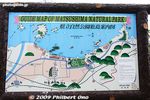
Map of Matsushima near Matsushima Kaigan Station. Places of interest include Ojima island, Matsushima boat cruise, Godaido island, Fukuura island, and Zuiganji temple.
|
|
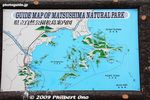
I show you photos of the boat cruise first. There are many boats coming and going in Matsushima Bay. You have to decide which cruise to go on.
|
|

Matsushima Pier. There are boats which go around the Matsushima islands and return to Matsushima. Others go to Shiogama (toward Sendai) or a longer route toward Oku Matsushima.
|
|

Most boat cruises cost 1400 yen, taking about 50 min. Boats leave almost every 30 min. The boat cruise is the main and most popular activity at Matsushima.
|
|

Next to the boat pier is this building selling cruise tickets. No reservations required. You can buy a ticket even 5 min. before departure.
|
|

THe Nio Maru boat which I rode for the cruise. For an extra 600 yen, you can go on the first-class upper deck. I waited until it got sunny later in the day, then went on the cruise. The islands look better when it's sunny.
|
|

Nio Maru at Matsushima Port.
|
|

Inside Nio Maru's lower deck. Comfortable and air-conditioned. The places of interest are explained in Japanese and English during the cruise.
|
|

As each boat leaves, sea gulls follow.
|
|

The sea gulls follow where there's food, and the tourists are happy to toss junk food at them.
|
|

They even sell bird food on the boat.
|
|

These birds fly very close, within arm's reach.
|
|

Face to face with a bird. "Hey, any food for me??"
|
|

The boat passes by numerous pine-clad islands of Matsushima.
|
|

THis is one of the more famous Matsushima islands, named Kanejima with three holes. 鐘島
|
|

Kanejima
|
|
|

THe name "Matsushima" of course means "Pine Islands," so you may hear "Matsushima" in other places in Japan wherever there are pine-clad islands.
|
|
|

Another famous and unique island in Matsushima is Niojima, shaped like a Deva King found at the gate of Buddhist temples. 仁王島
|
|
|

Matsushima would also be interesting to geologists.
|
|

Famous for centuries, Matsushima has inspired many haiku poets like Matsuo Basho and painters.
|
|
|
|
|
|
|

This was my favorite island in Matsushima.
|
|

Back to Matsushima Port.
|
|

Matsushima Rest House is next to the pier, where you can buy cruise tickets or just rest on chairs. Tourist info counter also provided.
|
|
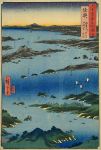
Hiroshige's woodblock print of Matsushima from his "Famous Views of the 60 Provinces" series.
|
|

Route 45 running parallel to the shore. Busy road with shops and restaurants.
|
|

Near the boat pier is this a large park called Chuo Hiroba.
|
|

Chuo Hiroba, where tour groups meet.
|
|

Nearby is Godaido temple on a small island close to shore.
|
|

Godaido is another famous and storied icon of Matsushima. In any painting or depiction of Matsushima, Godaido is always there.
|
|

Godaido enshrines five statues representing the Mikkyo teachings of Shingon Buddhism.
|
|

Godaido 五大堂
|
|

Godaido 五大堂
|
|

Way to Godaido.
|
|
|

way to Godaido
|
|

The first bridge to Godaidojima island.
|
|

Second bridge to Godaido.
|
|

Godaido temple in Matsushima. This building was built in 1604 by Lord Date Masamune.
|
|

Godaido was first erected in 807 called Bishamondo. We cannot go inside. Important Cultural Property.
|
|
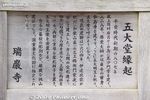
About Godaido
|
|

Godaido is also noted for wooden carvings of Eto zodiac animals. Cock.
|
|

Monkey
|
|

Boar
|
|

Another noted building in Matsushima is Kanrantei, perched on a low hill. Now it is a rest place where they serve tea.
|
|
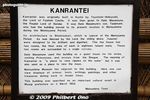
About Kanrantei
|
|

Original buildings and layout of Kanrantei.
|
|

Kanrantei
|
|

Entrance to Kanrantei.
|
|

Kanrantei
|
|

Inside Kanrantei where you can relax and have tea for a fee.
|
|

View of Matsushima from Kanrantei. The boat pier is straight ahead.
|
|

View of Matsushima from Kanrantei.
|
|

Matsushima Museum at Kanrantei.
|
|

Inside Matsushima Museum
|
|

Samurai armor and the Date crest
|
|

Folding screens
|
|

Folding screen with a painting of Matsushima.
|
|

Original letter written by Lord Date Masamune from a battlefield.
|
|
|
|

Near Godaido is this onument for Japan's Scenic Trio (Nihon Sankei) which are Matsushima, Amanohashidate (northern Kyoto), and Miyajima (Hiroshima). 日本三景
|
|

Matsushima Monument near Godaido
|
|
|

This odd-loking building calls itself Matsushima Castle. I saw nobody there so decided not to enter.
|
|

The second island to visit is Fukuurajima, a short walk from the boat pier. The island with the long red bridge is Fukuura island. You can't miss it. 福浦島
|
|

Fukuura island is larger than the other islands, and can take a good 30 min. to walk around it. If you don't feel like walking anymore, you may want to skip Fukuura. Most tourists don't go there, but I thought it was worth a visit.
|
|

Unless you want to swim to the island, you have to pay 200 yen to cross the bridge to Fukuura. Walk through the gift shop/restaurant and pay the toll to access the bridge.
|
|

Bridge to Fukuura island is named Deai Hashi. 出会い橋
|
|

Fukuura island offers nice walking trails and a few lookout points from where you can see other islands.
|
|

Fukuura island
|
|

Map of Fukuura island. Points 3 and 5 are worth seeing. You have to leave the island by 5 pm or (4:30 pm during winter months).
|
|
|
|
|
|

View from Fukuura island.
|
|
|
|

Bentendo Hall on Fukuura island.
|
|

Bentendo Hall on Fukuura island.
|
|

Lookout point on Fukuura island.
|
|

Bridge from Fukuura island back to mainland.
|
|

Way to Zuiganji temple. Matsushima also has a number of notable temples, and Zuiganji is the most famous, being a National Treasure. A short walk from the boat pier.
|
|

Gate to Zuiganji temple.
|
|

Wooded path to Zuiganji.
|
|

On the right side toward Zuiganji are these huge caves.
|
|

These Zuiganji temple caves were used to store the ashes of the deceased. THere are numerous Kannon statues and carvings. You see these caves, large and small, all over Matsushima.
|
|
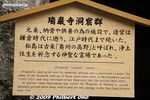
About Zuiganji temple caves.
|
|
|
|
|
|
|
|
|
|
|
|

This cave is marred by graffiti. Hope the offenders get cursed by the deceased.
|
|
|
|
|

Notice the steps on the left.
|
|

Monument for railroad workers.
|
|

Entrnce to Zuiganji temple.
|
|

At the Zuiganji temple entrance is a statue of Enmei Jizo, the Guardian Deity of Lnogevity.
|
|
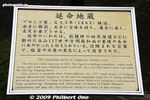
About Enmei Jizo, the Guardian Deity of Lnogevity.
|
|

Cave of graves.
|
|

Graves inside a cave near the temple entrance.
|
|
|

Path to Zuiganji's main hall. Admission charged.
|
|

From Sept. 2009, Zuiganji's Hondo main hall will be closed for major renovation. The construction offices are on the left.
|
|

Zuiganji lantern
|
|

Zuiganji temple's Hondo main hall. This building is a National Treasure. No photography allowed inside. Zuiganji is a Zen temple built in 828. This building was rebuilt in 1609 by Date Masamune.
|
|

I got to see the main hall before it was to be closed for several years for renovation. The Hondo will be renovated for the first time since it was built 400 years ago.
|
|

The building will be disassembled and reassembled. They expect to find some hidden historical artifacts during the process.
|
|

Renovations have already begun with adjacent buildings. I visited in Aug. 2009.
|
|

Kawara roof tiles.
|
|
|

Near the Hondo hall is this building called the Kuri.
|
|

Kuri was the Zen kitchen. You can go inside, but only in the entrance way. Nothing much to see.
|
|

Zuiganji Art Museum is right acros the Kuri.
|
|

Room built into the rock.
|
|
|
|
|
|

Next to Zuiganji is Entsuin, another noted temple in Matsushima even though it is not a National Treasure. A Zen (Rinzai school) Buddhist temple. Small admission charged.
|
|

Map of Entsuin built in 1646 by Date Tadamune, second lord of Sendai (after Masamune). He built it for his deceased son Mitsumune.
|
|

Date Mitsumune died at age 19 in Edo Castle, rumored to have been poisoned. His talents and abilities were feared by the Tokugawa.
|
|
|

Entsuin is most noted for its Japanese-style garden designed by Kobori Enshu. The garden is said to have been moved here from Date's Edo residence.
|
|
|
|
|

Way to Sankeiden at Entsuin temple.
|
|

Sankeiden hall at Entsuin temple is an Important Cultural Property. This is a mausoleum for Date Mitsumine. 三慧殿
|
|

Inside Sankeiden hall which also has a painting of a rose.
|
|

Altar inside Sankeiden with a statue of Mitsumune.
|
|

Entsuin"s caves
|
|
|

Daihitei hondo main hall of Entsuin. 大悲亭
|
|

Inside Entsuin's Hondo hall called Daihitei. It used to be the summer home of Mitsumune. Dedicated to Kannon, Goddess of Mercy.
|
|

Entsuin's Rose Garden バラの庭
|
|

Rose Garden and Daihitei.
|
|

It was early AUg. and hydrangea was still in bloom in Entsuin.
|
|

Entsuin
|
|

Sanseido hall for three saints. 三聖堂
|
|
|

Matsushima Green Hiroba is a waterfront park.
|
|

Ojima island is the third island worth visiting in Matsushima.
|
|

Ojima island is accessible by a red bridge.
|
|

Ojima island at Matsushima
|
|
|

Ojima is a small island, but larger than Godaido.
|
|

Ojima is dotted with numerous little caves and stone carvings of Kannon.
|
|
|
|
|
|
|

Ojima caves
|
|

Monuments and stones
|
|
|
|
|

This island is actually part of Zuiganji temple.
|
|
|
|
|
|

Haiku poem by Basho. No doubt that he visited this island too.
|
|
|

View from Ojima.
|
|
|
|

View from Ojima
|
|

Matsushima
|
|

Nice walking path on Ojima
|
|

Lookout point
|
|
|
|
|

Torii to a shrine on Ojima island, Matsushima
|
|

Shrine on Ojima
|
|
|
|
|

Matsushima Kaigan Station
|
|

Even the pointer markings where the train doors will open have a photo.
|
|
|
|
|